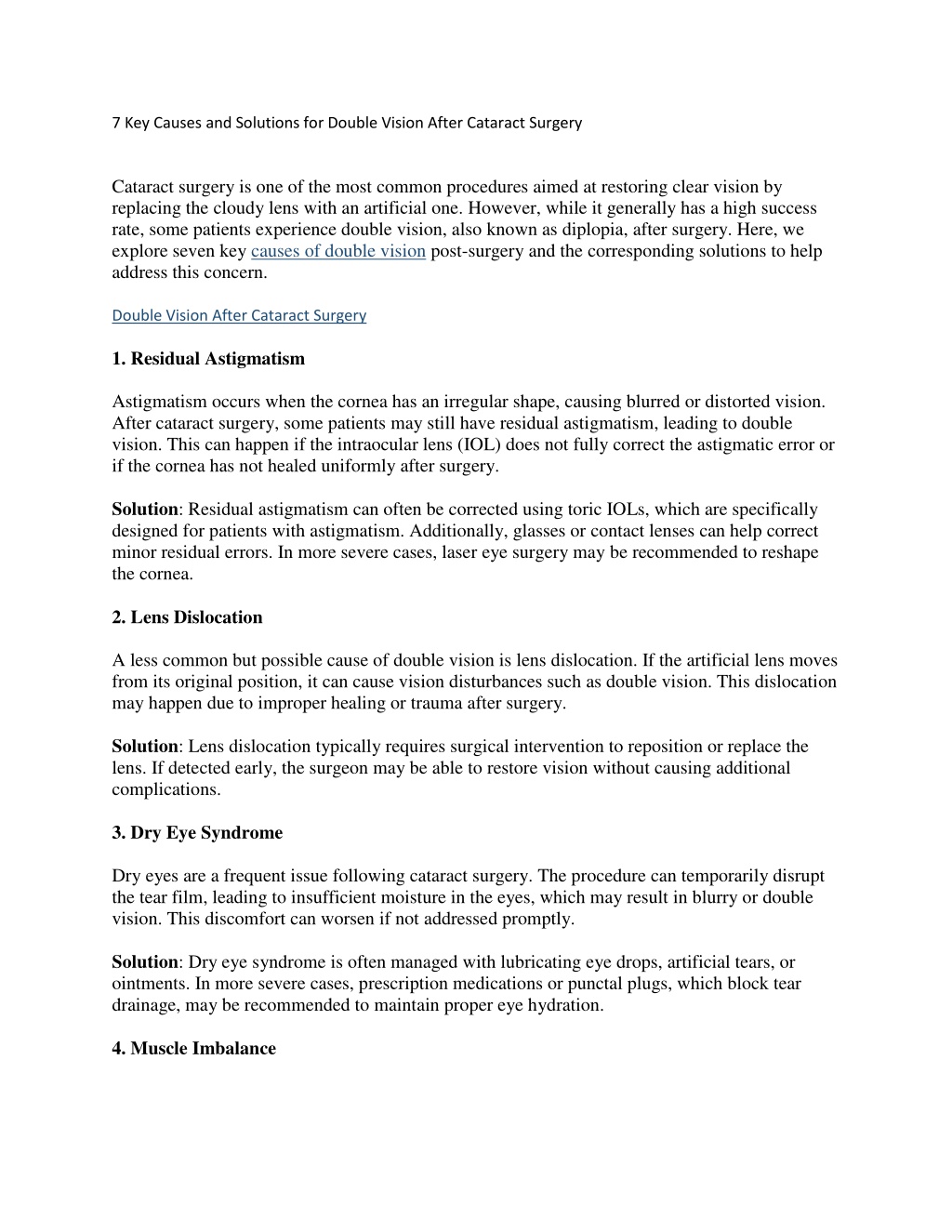
7 Key Causes and Solutions for Double Vision After Cataract Surgery
Cataract surgery often restores clarity to your vision, but some patients may experience difficulty with near vision tasks, such as reading or using a smartphone. This guide outlines essential steps to enhance near vision post-surgery. //healthywz
Download Presentation

Please find below an Image/Link to download the presentation.
The content on the website is provided AS IS for your information and personal use only. It may not be sold, licensed, or shared on other websites without obtaining consent from the author. Download presentation by click this link. If you encounter any issues during the download, it is possible that the publisher has removed the file from their server.
E N D
Presentation Transcript
7 Key Causes and Solutions for Double Vision After Cataract Surgery Cataract surgery is one of the most common procedures aimed at restoring clear vision by replacing the cloudy lens with an artificial one. However, while it generally has a high success rate, some patients experience double vision, also known as diplopia, after surgery. Here, we explore seven key causes of double vision post-surgery and the corresponding solutions to help address this concern. Double Vision After Cataract Surgery 1. Residual Astigmatism Astigmatism occurs when the cornea has an irregular shape, causing blurred or distorted vision. After cataract surgery, some patients may still have residual astigmatism, leading to double vision. This can happen if the intraocular lens (IOL) does not fully correct the astigmatic error or if the cornea has not healed uniformly after surgery. Solution: Residual astigmatism can often be corrected using toric IOLs, which are specifically designed for patients with astigmatism. Additionally, glasses or contact lenses can help correct minor residual errors. In more severe cases, laser eye surgery may be recommended to reshape the cornea. 2. Lens Dislocation A less common but possible cause of double vision is lens dislocation. If the artificial lens moves from its original position, it can cause vision disturbances such as double vision. This dislocation may happen due to improper healing or trauma after surgery. Solution: Lens dislocation typically requires surgical intervention to reposition or replace the lens. If detected early, the surgeon may be able to restore vision without causing additional complications. 3. Dry Eye Syndrome Dry eyes are a frequent issue following cataract surgery. The procedure can temporarily disrupt the tear film, leading to insufficient moisture in the eyes, which may result in blurry or double vision. This discomfort can worsen if not addressed promptly. Solution: Dry eye syndrome is often managed with lubricating eye drops, artificial tears, or ointments. In more severe cases, prescription medications or punctal plugs, which block tear drainage, may be recommended to maintain proper eye hydration. 4. Muscle Imbalance
Cataract surgery can sometimes cause eye muscle imbalance, particularly in patients with pre- existing strabismus (misaligned eyes). This can lead to double vision, as the eyes are no longer working in unison to focus on an object. Solution: Prism glasses are a non-invasive option that can help align the eyes and reduce double vision. In cases where the muscle imbalance is more severe, surgery to correct eye alignment may be necessary. 5. Corneal Swelling (Edema) Corneal edema, or swelling, is a common side effect of cataract surgery. Swelling in the cornea can cause light to scatter as it enters the eye, leading to blurred or double vision. The condition usually resolves as the eye heals but can persist in some patients. Solution: Mild corneal swelling can be managed with anti-inflammatory eye drops or ointments. In cases where swelling is more pronounced, hypertonic saline drops or ointments may help reduce the fluid buildup in the cornea. If the edema does not resolve over time, further medical intervention may be required. 6. Posterior Capsule Opacification (PCO) Also known as a secondary cataract, PCO occurs when the back of the lens capsule becomes cloudy after cataract surgery. This cloudiness can result in double or blurred vision, mimicking the effects of the original cataract. Solution: Posterior capsule opacification is typically treated with a YAG laser capsulotomy, a quick, painless procedure that clears the clouded capsule. Vision usually improves immediately after the treatment. 7. Infection or Inflammation Although rare, infections or inflammation (such as endophthalmitis) can occur after cataract surgery. This can lead to a range of vision problems, including double vision, and requires prompt medical attention. Solution: Infections are treated with antibiotics or antiviral medications, depending on the cause. Anti-inflammatory drops are also prescribed to reduce swelling and discomfort. In severe cases, surgical intervention may be required to prevent long-term damage. Conclusion Double vision after cataract surgery can be distressing, but understanding the causes can help address the issue effectively. While many cases of double vision are temporary and resolve as the eyes heal, some may require further intervention. Patients experiencing prolonged double vision should consult their eye surgeon to determine the underlying cause and receive appropriate treatment.






















